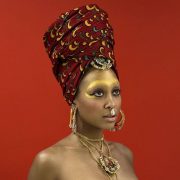#CultureCheck – African Head Ties In The UK

Are you woke?
Would you consider yourself rooted, grounded? Our generation arguably burst the bubble of what is a popular culture history of appropriation. I mean come on, we can all think back to at least one 90’s music video where something was appropriated like there’s no damn tomorrow. Which is why I present to you this series, #CultureCheck. A cohesive discussion, fuelled by the perspectives of the natives, dedicated to giving you recognition, insight and a brief throwback history lesson, into their cultural fashion and more; it’s going to make you miss GCSE history I promise; (the decolonised aspects anyway).
I will ask 5 young adults weekly, what they think and feel about a piece of their cultural clothing/accessory and how it defines them in this generation. There is no right or wrong answer, only enlightenment, education and respect. So if you’ve ever worn a bindi on your forehead for Wireless Festival, and wondered how problematic it probably was, look no further. In these weekly sessions, we’ll hear about the history, quicker than an Instagram star can rename it something trendy, from people born into the heritage themselves.

The accessory of acclaim this week is none other than the glorious – African Head Tie. A piece of attire, I would say is often overlooked and denounced of recognition, as many people know of the Head Tie, and can probably guess it originated from Africa, but do they know the name? Where it derived from? That it’s symbolic? If you don’t know about African Head Ties, and the many glorious shapes and sizes they take silhouette in fear not, as there is a brief history lesson, provided from research, and the native people themselves, courtesy of your host of course!

African Head Ties are worn internationally but derived from Africa decades ago. They vary in method, style and visualisation depending on ancestry. The headwear is worn every day by some, and just for special occasions by others. In South Africa and Namibia, the traditional head cover choice for elder women is named ‘Doek‘, while individuals of other ages may opt for a ‘Duku‘ instead. ‘Duku’ is typically used as the head tie term in Malawi, Ghana and neighbouring countries, while ‘Dhuku‘ is prominent in Zimbabwe and the surrounding areas. ‘Tukwi‘ is the name of the head tie in Botswana and near areas, while ‘Gele‘ is foremost in Nigeria, Ghana and other adjacent countries. The terms are fluid throughout the regions research shows, so expect some of these terms to be used in differed countries not listed, however for a guideline of areas this is a resourceful reference. Remember to comment, continue the conversation and engage so the information only spreads further by #CultureCheck.
Back to business, and these are the questions I asked the wonderful participants of the discussion. The individuals are from a variety of backgrounds and identities and answer by the guideline below.
- How does your cultural item make them feel?
- What does it mean to you and why and where do you choose to wear it?
- Do current times challenge and alter your desires to wear it?
‘I wear my Head Tie because it allows me to embrace my culture. I feel like it brings out a beauty in the sense where you can see me, for all my features and everything I am. I wear my Head Tie because it’s our tradition, the same way other countries have their traditions’ – Anonymous.
‘When I wear my Head Tie I feel fabulous. I only wear Head Ties for special occasions like my mother’s 50th birthday. In the past, I found it embarrassing to wear as I never liked the feeling of eyes on me, since Head Ties can be quite eye-catching, but as I grew up I also grew confident and comfortable with my culture, so now I post pictures on social media in my full attire not caring what others think’ – Anonymous.
‘It’s a cultural thing our mothers do, and so we do it too. It doesn’t have any particular meaning to me. It’s just beautiful. I don’t wait for a particular occasion to wear it, I wear it whenever I feel like it – and that’s because I look beautiful with it. It makes me feel beautiful and African’ – Adwoa Nicoletta
‘I don’t really wear my Head Tie as I don’t need to, and my hair usually is styled, but I acknowledge and think they look elegant’ – Anonymous.
‘My Head Tie is a visual representation, of the royalty I see in my Yoruba heritage. It’s versatile, majestic and a literal crown. I wear a Head Tie for special events such as weddings and birthdays. I wasn’t comfortable wearing one as a child, for fear of looking like an ‘aunty’, however as I’ve grown and matured it has become something I take great pride in. Saying that, my Head Tie also makes me feel unique, as I can opt to wrap it in a number of unique fashions that define my style. I also feel my generation has really embraced our traditions, in doing so we’ve managed to establish our own identities, particularly in regards to many of us who have dual citizenship, whilst also putting our own stamp on it. ‘ – Vicky, 25.
History lesson over. Now for our final exercise please take out a pen, and draw a square on your page. Then, tick the square, because you’ve just had a #CultureCheck. Use the hashtag, share your inner-most thoughts and feelings, and I’ll catch you next week for our next lesson.
#CultureCheck – © 2018




![ZINO VINCI’S ‘FILTHY & DISGUSTING’EP BRINGS YOU TO THE CORE OF THE ARTIST [@ZinoVinci]](https://guap.co/wp-content/uploads/2023/10/Zino-4.jpg)



